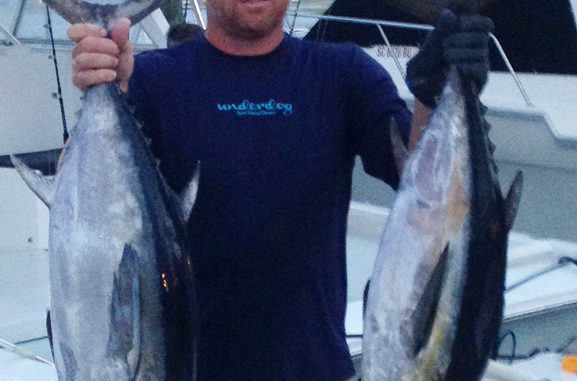
SC offshore anglers expect March treat
In South Carolina, offshore fishing kicks into gear about the same time spring arrives. While anglers may have picked up a few trophy wahoo over the winter, March is when fish boxes begin to fill, and the bumper catches have T-U-N-A written all over them.
Shawn Thomas of Underdog Sport Fishing Charters heads to the nearest offshore edge as soon as water conditions are favorable for tuna arrivals, and temperature is his key indicator.
“Tuna migrate northward from Florida when the water begins to warm. Incrementally, each month, new waves of fish arrive into our waters,” said Thomas (843-655-5890). “Above 68 degrees is ideal for our offshore fish, but 72 degrees is the magic number for tuna and wahoo.”
Tuna prefer a certain temperature range, and Thomas said 68 to 77 degrees is where he’s had the most success on spring blackfin. He will target ledges with an 8- to 10-rod spread of cedar plugs, lures and ballyhoo, with and without sea witches. His spread will dupe everything, including dolphin, wahoo and tuna.
“We are also wahoo fishing when looking for tuna because everything will usually be concentrated in the same areas around the bait — bait holds tuna, and wahoo eat the tuna. If you find one, you can find the other,” he said.
When the tuna are thick and feeding well near the surface, Thomas will switch to cedar plugs and similar lures because they are quicker to deploy when the bite is on fire.
Thomas said the blackfin bite is best during periods of low light, such as early morning, late evening and cloudy conditions.
“You can catch them all day when it is overcast and you have substantial current flow from a tide change,” he said.
Even though most anglers think of tides being inshore, the tide cycle has a significant bearing on the feeding activity in pelagic environments, too. Thomas prefers the tide falling or rising to create current flow across the deep-water ledges. He prefers the last two hours of the falling tide but says water movement — one way or the other — is critical to a hot offshore bite.
“When you have water rolling in from 1,000-foot deep water across the 150-foot ledges, bait gets sucked up over the hump, and the fish are there waiting for it. After the tide changes and the water starts racing across the ledges, the bite takes off,” he said.
Tuna are a favorite of offshore anglers in the Carolinas, and blackfin are the most abundant off South Carolina, much moreso bluefin, yellowfin, big eye and skipjacks, and they comprise the biggest catches for South Carolina offshore aficionados. When conditions become favorable in the spring, charter boats make daily trips to the bluewater to collect limits of these tasty, line- stretching sensations.


Be the first to comment